The One Pillar Pagoda is one of Hanoi’s most famous Buddhist pagoda and statued in Ho Chi Minh Complex together with Ho Chi Minh Mausoleum, the Presidental Palace, Ho Chi Minh Museum. Besides the Perfume Temple and Tran Quoc Pagoda, the One Pillar Pagoda is one of Vietnam's two most iconic worshipping places representing the long-established culture and religion of Vietnam.
History of One Pillar Pagoda
Legend claims that the existence of this special architecture pagoda associated with Emperor Ly Thai To. The aging King was sorrow for the fact that he had no children, came to the pagodas, and prayed Buddha for a son. Once upon a night, the spirit of Bodhisattva Avalokiteshvara visited him in a dream. The great spirit seated on a giant lotus flower and handed the king a baby boy. Months after that, the Queen gave birth to a boy. Remembered his dream, the King ordered to build a pagoda which was supported by one pillar only. The unique shape resembled the lotus seat, was a tribute of Ly Thai To to the ethereal spirit of Bodhisattva Avalokiteshvara. On the outside, the pagoda looks like a giant lotus blooming from the water.
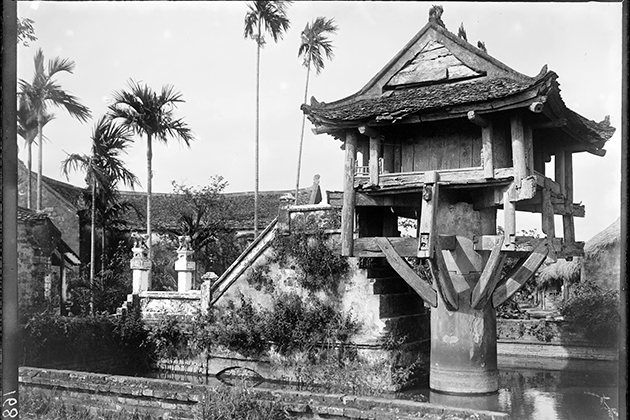
One Pillar Pagoda which was built in 1049 in the Ly Thai Tong dynasty was originally located in the Tay Cam Garden, Thach Bao, Vinh Thuan District, Thang Long Capital. The whole structure of the pagoda stands on one sole stone pillar and remains unchanged. However, the surrounding areas have long ago altered, ancient streets disappear through several dynasties, and now, surrounding the One Pillar Pagoda is the Ho Chi Minh Complex. Under the Ly Dynasty, the One Pillar Pagoda took the role as a place of the annual royal ceremony celebrating the birthday of Gautama Buddha. Monks and laymen would gather to attend a special Buddha-bathing ceremony, where the monarch would free a bird, symbolized an act of respecting lives.
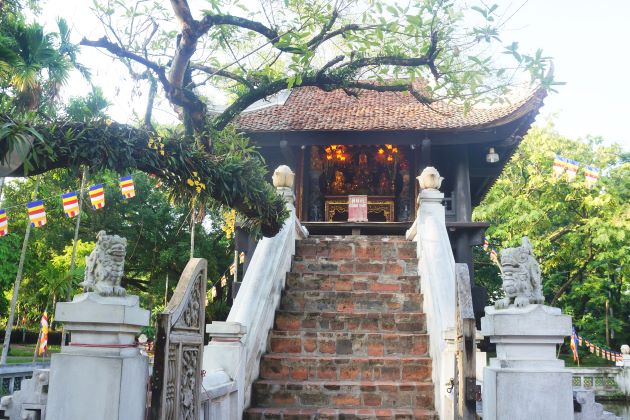
Like most of the other historical monuments in Hanoi and Vietnam, the One Pillar Pagoda has suffered from war effects. In 1954, before losing in the First Indochina War and withdrawing from Vietnam, the French colonists had destroyed the pagoda. What visitors see today is a replica rebuilt by the Vietnamese Governors, with the old stone pillar replaced by a new concrete one. However, all details and architecture features remain the same.
The Uniqueness of One Pillar Pagoda
The One Pillar Pagoda is specially designed to resemble a lotus blossom, one of the reasons why it was chosen as a symbol of Vietnam. Lotus is Vietnam’s national flower; its meaning was praised in folk poems “In the pond, nothing’s more beautiful than lotus, the flower of the dawn”. Along with the tradition of Vietnam, lotus has been seen as an emblem of purity, serenity since it rises above the muddy water and still maintains such exquisite beauty. Similarly, the pagoda is located on a muddy pond, rests on one single pillar, with four corners stretch out – a perfect demonstration of a giant lotus. The pillar is 1.25 m in diameter, supporting the whole pagoda above, which is used as a space for Buddha worshipping.
Right on top of the column is a statue of Guan Yin Buddha on a lotus. The pagoda was built completely by wooden. On each curving roof, a dragon symbol was carved. One Pillar Pagoda is considered one of the top special pagoda architecture in Asia. On the garden behind the pagoda, there is a Buddha Gaya tree – a gift from President Rajendra Prasad on the occasion of President Ho Chi Minh visiting India in 1958.
Highlights of One Pillar Pagoda
One Pillar Pagoda is a unique architecture representing the religious tradition of Buddhism in Vietnam and also one of the most well-known attractions in Hanoi day trips. Below are some of the reasons why a visit to the One Pillar Pagoda is worth considering:
- Mark your stay in Vietnam by visiting one of its most proud symbols: The image of One Pillar Pagoda used to be carved on one side of the 5000 VN penny. Now, images featuring One Pillar Pagoda still appear a lot in traditional paintings, decorations, and Vietnam souvenirs.
- Observe a unique architecture: In 2012, the Asian Records Academy has recognized the One Pillar Pagoda as “Pagoda of Most Special Architecture”. Every tourist visiting the One Pillar Pagoda is taken a surprise at the “one of a kind” feature and shape of the architecture.
- A great place for Buddha worshippers: With the age of more than 1000 years, the One Pillar Pagoda is a proud reflection of Vietnam’s tradition of worshiping Buddha. Moreover, the pagoda is rumored to possess strong spiritual and holy power, where prayers are likely to be granted their wish.
One Pillar Pagoda Entrance Fee & Opening Hours
How to Get One Pillar Pagoda
The One Pillar Pagoda is located within the Ho Chi Minh Complex. For visitors getting to the Ho Chi Minh Complex by private transportation, parking is available at the entrance gate of the Ho Chi Minh Museum. Buses number 09, 34, 22 all offer a stop at Le Hong Phong Street, just less than minutes walk to the Ho Chi Minh Complex.
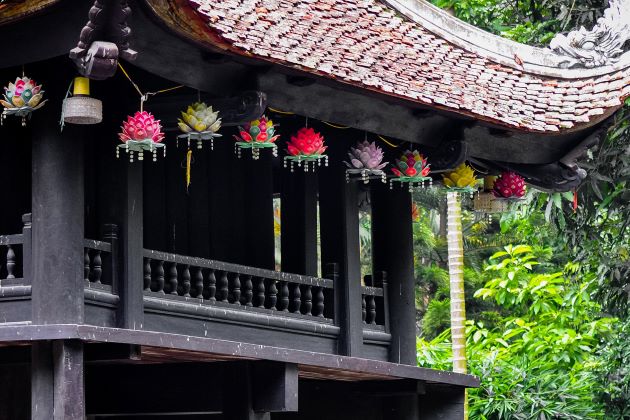
One Pillar Pagoda Opening Hours
The One Pillar Pagoda, as well as the Ho Chi Minh Complex, is open on all day of the week.
- In summer (April 1st to October 31st): From 7.30 to 10.30 and 13.30 to 16.30
- In winter (November 1st to March 31st): From 8.00 to 11.00 and 13.30 to 16.30
One Pillar Pagoda Entrance Fee
Both domestic and international tourists are free to enter One Pillar Pagoda

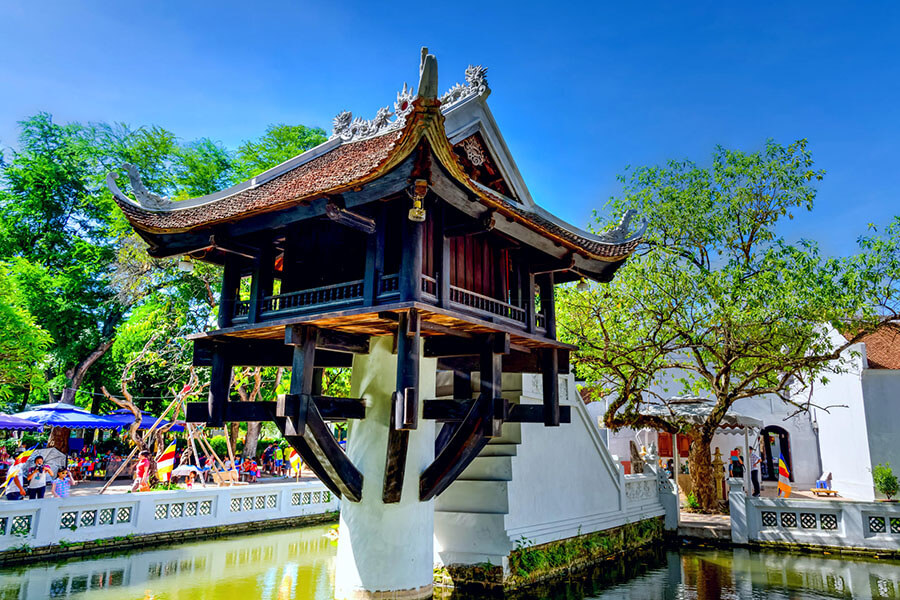
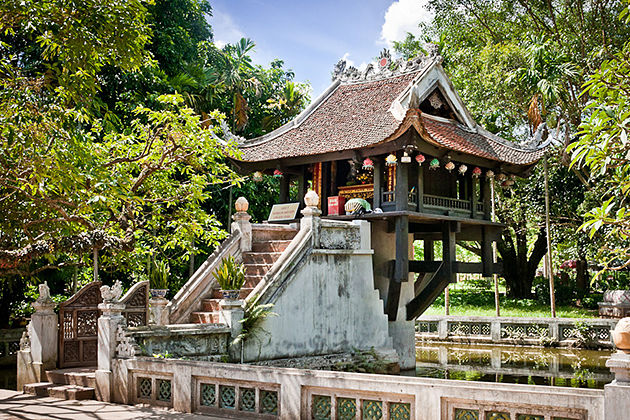
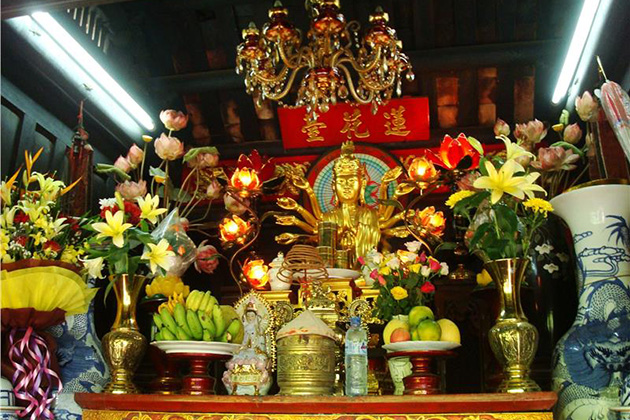
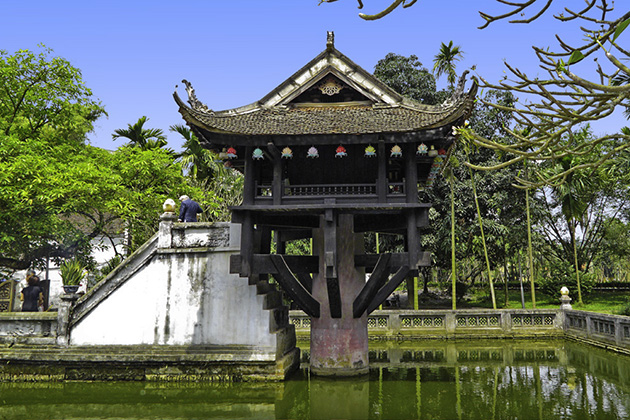


One Pillar Pagoda (Chua Mot Cot, in Hanoi, often taken as the emblem of Hanoi). Official name: Dien Huu (Prolongation of life span) thus called to express a wish for the longevity of the Ly King when the pagoda was built in 1049. According to the stele of Long Doi pagoda (in Ly Nhan, Ha Nam, 1121), in the center of Linh Thieu lake, a stone pillar was erected supporting a thousand petal lotus which rests on a small red pagoda. This architecture reflects a mixture of Buddhist conceptions and the cult of agricultural fertility (Buddha: emancipation; Red pagoda: perfect bliss; Lotus: illumination; Stone pillar: transport of vital energy to the earth and water).
At the present stage, there is only one square pagoda with 4 roofs resting on a masonry (with a Quan Am statue of multiple arms). In front is a recent construction. According to the legend, King Ly Thai Tong, having no son, saw in his dream Goddess Quan Am sitting on a lotus flower giving him a male baby. Sometime later, he took as wife a young girl he met in a garden and had with her a son. Hence the construction of a pagoda evoking the flower.